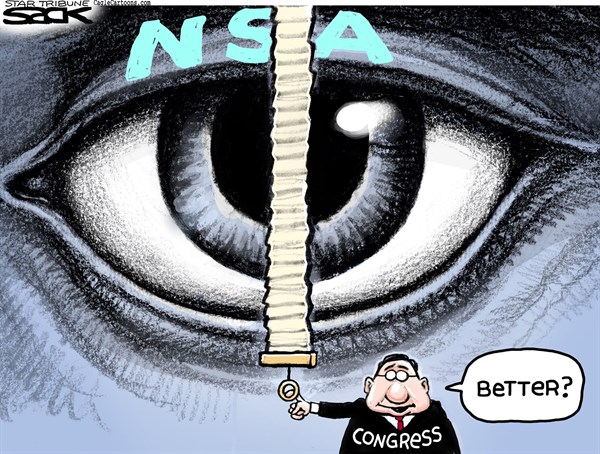
( Nat collaborated with his son, Nick Hentoff, on this week's column.)
The Cato Institute will host its Second Annual Surveillance Conference this week. The symposium -- which will be live-streamed on the Internet and available on the Cato Institute's website for later viewing -- promises a gathering of "top scholars, litigators, intelligence officials, activists and technologists working at the intersection of privacy, technology and national security."
I think that the first academic symposium on the legal and policy implications of surveillance technology was held more than 40 years ago at Columbia University and published in 1972 by Columbia's Human Rights Law Review (HRLR). I was asked to write the foreword to the collection of articles from the symposium, published in book form as "Surveillance, Dataveillance and Personal Freedoms: Use and Abuse of Information Technology" (R.E. Burdick, 1973).
Ironically, you can't read this book on the Internet.
"Never before in the history of this country has ... secret surveillance been so pervasive," I wrote in the foreword. "All the more dangerous to the personal freedoms of every citizen is that this degree of surveillance has been made much more omnivorous because of the swift advance in the technology of surveillance."
What I wrote 40 years ago is, unfortunately, as true today as it was in 1973.
The articles in this book predate the investigations in the 1970s by the Rockefeller Commission, and the congressional Pike and Church Committees, all of which revealed longstanding surveillance abuses by the U.S. intelligence community. The HRLR symposium articles, and the subsequent findings of these congressional investigations, were prescient warnings of what Americans should have been expecting in the future from a surveillance state left unchecked by a lack of firm oversight and strict accountability
Sen. Sam Ervin, a North Carolina Democrat who later served as the chairman of the Senate Watergate Committee, contributed a long article on "The First Amendment: A Living Thought in the Computer Age."
An article by HRLR staff members on "Police Use of Remote Camera Systems for Surveillance of Public Streets" examined the policy and constitutional implications of an experimental, federally funded program in the small town of Mt. Vernon, New York.
HRLR editor Donald R. Davis' article on "Police Surveillance of Political Dissidents" coined the term "dataveillance," and anticipated the type of NSA mass surveillance programs exposed by Edward Snowden in 2013: "The ... manipulation and management of vast quantities of disparate bits of ... presently stored information ... for the purpose of retrieving, collating or evaluating those bits of information relevant to the subject of the record check."
Only those unaware of the NSA's program, codename Project SHAMROCK, would have been shocked by Snowden's revelations about the NSA's mass collection and surveillance -- with the cooperation of private telecom companies -- of Internet and phone communications to, from and transiting the U.S.
On Aug. 31, 1975, The New York Times published an article by Nicholas M. Horrock headlined "National Security Agency Reported Eavesdropping on Most Private Cables." Horrock reported that during the three decades following World War II, the NSA had collected and surveilled, on a daily basis, copies of most telegrams going to, coming from and transiting the United States, with the active cooperation of three private companies: Western Union, RCA and ITT. Before it was voluntarily shut down in 1975, the NSA was intercepting as many as 150,000 telegrams a month.
Project SHAMROCK was first discovered by L. Britt Snider, a staff lawyer on the Church Committee who later became the CIA's Inspector General. Snider memorialized his recollection of a 1975 briefing on the NSA surveillance program years later in an article titled "Unlucky Shamrock." According to Snider, the data was "electronically processed for items of foreign intelligence interest" and then disseminated by the NSA to the FBI, the Secret Service, the Bureau of Narcotics and Dangerous Drugs and the Department of Defense.
Snider recalled that "(w)hile telegrams sent by U.S. citizens to foreign destinations were also present in the tapes NSA received, the briefer said that, as a practical matter, no one ever looked at them."
This is a justification familiar to those who have followed the government's awkward response to Snowden's revelations: that Internet and phone communications by U.S. citizens were swept up, along with the targeted foreign communications, by the NSA's modern mass surveillance programs.
The persistent deployment by the U.S. government of increasingly effective surveillance technology has been a constant in American society for nearly a century. This constant is what Sen. Ervin described in his HRLR article as "the insatiable curiosity of government to know everything about those it governs" and "the ingenuity applied by government officials to find out what they think they must know to achieve their ends."
Which is why it is important for activists to not only focus on current threats to civil liberties, posed by existing surveillance technologies, but to also understand the historical context of those threats while continuing to anticipate the next technological incarnation of the same threats far into the future.
Comment by clicking here.
Nat Hentoff is a nationally renowned authority on the First Amendment and the Bill of Rights and author of several books, including his current work, "The War on the Bill of Rights and the Gathering Resistance".



 Contact The Editor
Contact The Editor
 Articles By This Author
Articles By This Author